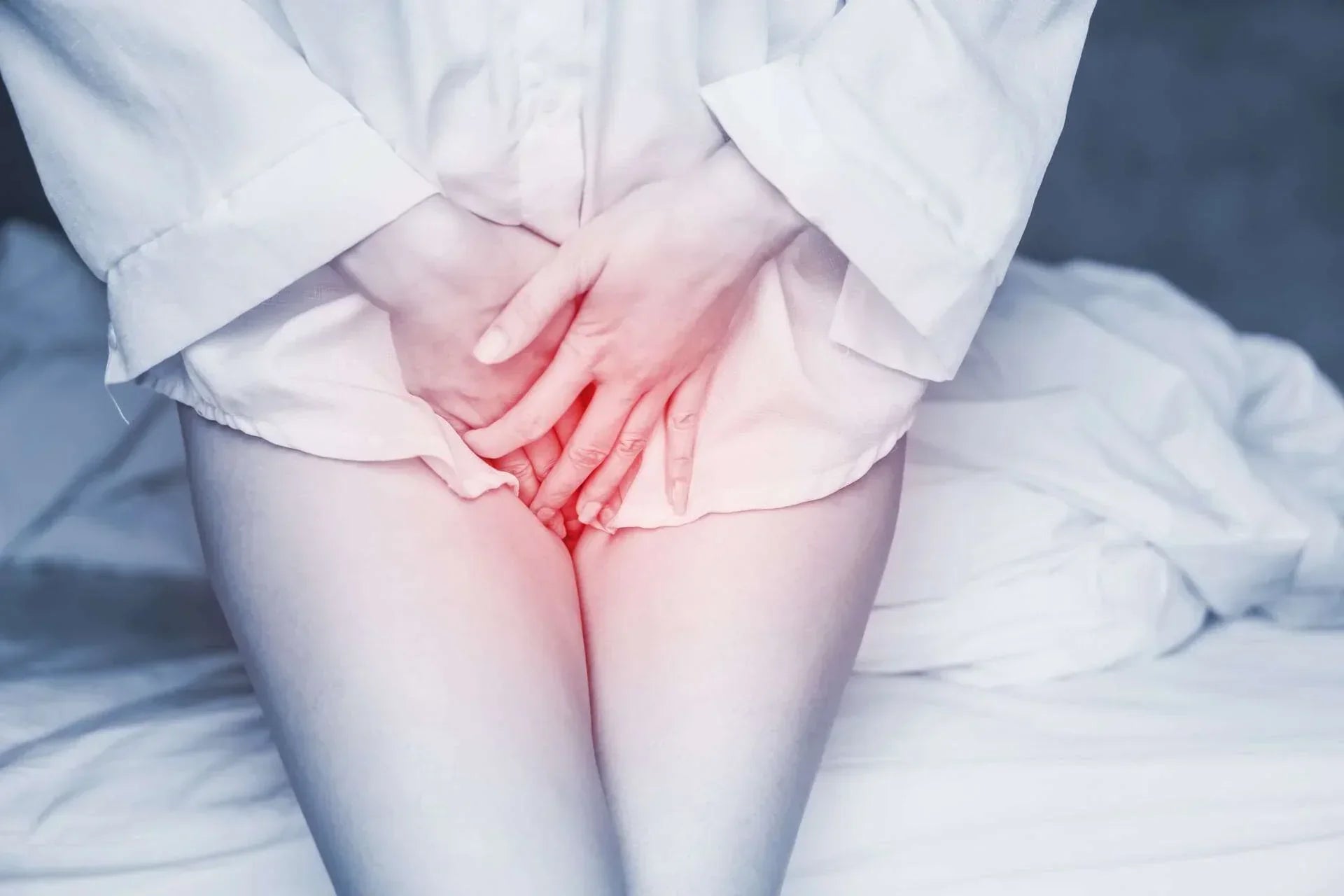Normal vaginal discharge is a discharge of fluid and cells that are continuously released through the vagina. The quantity, colour, smell, and consistency vary according to each stage of menstrual cycle. It can be a clear liquid or whitish and sticky. Being aware of changes in its characteristics is important because it ceases to be normal when it presents an unusual smell or appearance, such as a brown discharge, which may indicate that menopause is approaching (Mayo Clinic, 2019; Burgess, 2020). Naturally, a normal discharge helps keep the vagina clean and vaginal tissues healthy. It also provides lubrication and protects against infection. Changes in its appearance, accompanied by other symptoms such as burning, itching, or irritation may indicate a health issue. Among them, the presence of a vaginal infection by fungus or a sexually transmitted infection (De Pietro, 2019; NHS, 2021). Know the different causes for why brown discharge occurs during the transition to menopause or perimenopause and what to do in each situation.

Causes of brown discharge during perimenopause
Vaginal discharge happens almost daily. It is fluid and transparent or white, but it can change. When it is brown, it may contain small amounts of old blood that has taken longer to leave the uterus. For women between 40 and 50 years, brown discharge before a period may be a sign that you are approaching menopause (Burgess, 2020). During this stage, there is a considerable decrease in oestrogen. In addition, the tissues of the vagina lose thickness, moisture and elasticity, altering the pH of the area. Brown discharge may indicate that ovulation is coming to an end. However, it can also signal several changes affecting the urogenital area of women in menopause, such as atrophic vaginitis, infections, and others (Instituto de la Menopausia, n.d.).
1. Atrophic vaginitis
Atrophic vaginitis is thinning, dryness, and inflammation of the vaginal walls. It can happen when your body has fewer female hormones (oestrogen), and more often at menopause. It makes sex painful and can cause frustrating urinary symptoms. Your signs and symptoms may include (Mayo Clinic, 2021):
- Vaginal dryness.
- Vaginal burning and itching.
- Brown discharge vaginal.
- Urgency and burning when urinating.
- Recurrent urinary tract infections.
- Urinary incontinence.
- Mild discomfort and bleeding after sex.
- Shortening and tightening of the vaginal canal.
To treat atrophic vaginitis, you can use vaginal moisturisers or water-based lubricants that are over-the-counter treatment options. If these do not relieve symptoms, your doctor can prescribe topical or oral oestrogen hormone therapy (Mayo Clinic, 2021). A lifestyle change is also recommended. Healthy eating and regular physical activity can help relieve your symptoms. Even the use of alternative medicine with herbal supplements such as black cohosh or red clover can help (Mayo Clinic, 2021).
2. Vaginal infection
During the years of fertility, including the stage of perimenopause, the cause of brown discharge may be a vaginal infection. Among the most common are bacterial vaginosis, candidiasis (a yeast infection) and bacterial vaginitis and trichomonas that is transmitted through sexual contact. These include symptoms such as (MedlinePlus, 2019; Barad, 2020):
- Itching, redness, and swelling in the genital area.
- Irritation and bad smell in the vagina.
- Fever and abdominal pain or the pelvis.
Vaginal infection occurs when protective bacteria living in the vagina descend and harmful bacteria increase. The proliferation of these harmful microorganisms can occur due to the prolonged use of antibiotics, since they reduce the number of protective bacteria, and this decreases vaginal acidity. Furthermore, poor hygiene or frequent douching, pregnancy, diabetes mellitus or a foreign body in the vagina can also be causes. (Barad, 2020). Treatment depends on the cause, so seek medical attention. For example, bacterial vaginosis is treated with antibiotics. Corticosteroid creams or oral antihistamines may also be used. Home care is important, so keep the genital area clean and dry. Moreover, avoid using chemicals such as detergents, sprays, and soaps that contain surfactants, perfumes, alcohol, vinegar, iodine, and others that can irritate the vagina (MedlinePlus, 2019; Barad, 2020).
3. Polycystic ovary syndrome
Polycystic ovary syndrome (PCOS) is a hormonal imbalance that can appear at childbearing age and continue as you approach menopause. It can cause brown discharge due to mild irregular bleeding and other symptoms such as (OASH, 2019; Burgess, 2020)
- Irregular periods, very heavy or not having more periods.
- Excessive hair on the face or body, or hair loss.
- Acne or oily skin on face, chest and back.
- Pelvic pain.
- Patches of discoloured dark skin.
- Weight gain or difficulty losing weight.
These symptoms should be treated by a doctor, as there are several treatments available. Among them: drugs that contain oestrogen and progesterone, and those that block the effect of androgens (male sex hormone). In addition, healthy eating habits and regular physical activity can help relieve PCOS-related symptoms (OASH, 2019).
4. Sexually transmitted diseases
The brown discharge before a period or during perimenopause may be caused due to a sexually transmitted disease (STDs), such as gonorrhoea or chlamydia (Menopause Institute, n. d.). These are infections that are passed from one person to another through sexual contact. Your symptoms may include (NHS, 2021; MedlinePlus, 2021):
- Burning sensation and pain when urinating.
- Abdominal pain and fever.
- Lumps or growths of skin around the genitals or anus.
- Rash and itching of the genitals.
- Blisters and sores around the genitals.
- Warts around the genitals, anus, mouth, or throat.
Most STDs caused by bacteria or parasites like chlamydia are easy to treat with antibiotics prescribed by a doctor. Those caused by viruses such as human papillomavirus (HPV) have no cure, but medications can help with symptoms and reduce their spread (NHS, 2021; MedlinePlus, 2021).
5. Pelvic inflammatory disease
Pelvic inflammatory disease (PID) is an infection of the reproductive organs that can occur during perimenopause. It causes a brown discharge due to inflammation in the uterus such as endometriosis, bacterial vaginosis or inflammation in the ovaries. In addition, it presents other symptoms, such as (Burgess, 2020; Sedicias, 2021):
- Abdominal or pelvic pain.
- Fever.
- Pain during sexual intercourse.
- Smelly vaginal discharge.
- Burning sensation when urinating.
If you are experiencing any of these symptoms, please visitor your doctor to diagnose PID. They may prescribe oral or ointment antibiotics, fever medications, and anti-inflammatory drugs (Burgess, 2020; Sedicias, 2021).
6. Cervical cancer
In extreme cases, the brown discharge in perimenopause may indicate cancer, including that of the cervix (Instituto de la Menopausia, n.d.). It can occur from the development of abnormal cells, mainly from HPV infection. Symptoms include (Mayo Clinic, 2021):
- Pain during sexual intercourse.
- Bleeding after sex, between periods, or at menopause.
- Brown discharge abundant and foul-smelling.
If you suspect cervical cancer, you should consult a doctor. Treatment options include surgery to remove the cancer, radiation therapy, chemotherapy, and more. You can reduce your risk of developing HPV by protecting yourself against HPV and making better lifestyle choices (Mayo Clinic, 2021).
7. Pregnancy
Sporadic and random ovulations that are difficult to predict occur during perimenopause. Therefore, natural pregnancy is still possible if you have unprotected sex. As such, brown discharge, may be an early sign of pregnancy. Occasionally, it can even indicate an ectopic pregnancy or a miscarriage (Pérez & Salvador, 2020; Burgess, 2020). The most common early signs and symptoms of pregnancy include (Mayo Clinic, 2019):
- Lack of menstruation.
- Tender, swollen breasts.
- Increased frequency of urination.
- Fatigue and mood swings.
- Swelling and cramps.
- Light spotting, like a brown discharge.
- Constipation and nasal congestion.
Take a pregnancy test to determine. If positive, you should start prenatal care to relieve symptoms. Take prenatal vitamins, eat healthy, exercise, and avoid substances that can harm your baby (Mayo Clinic, 2019, MedlinePlus, 2020).
Alarm signs for brown discharge to seek medical attention
If you are experiencing Brown discharge during perimenopause, there are warning signs that you should be aware of such as (Burgess, 2020; Barad, 2020):
- If it continues for several weeks.
- It often happens after sex.
- Also, it smells bad.
- It is accompanied by other symptoms, such as abdominal or pelvic pain, vaginal itching or cramping.
- Fever, pus, and burning.
By experiencing any of the symptoms causing the brown discharge, it is best to consult your doctor. It can appear as a result of the normal process of perimenopause, or as a result of a vaginal disease or infection. To feel better, change your lifestyle with healthy eating, regular physical activity, and protection during sex. This will help relieve symptoms or delay their onset.
References
Barad, D. (2020). Vaginal discharge. Center for Human Reproduction. MSD Manuals. https://www.msdmanuals.com/es/hogar/salud-femenina/s%C3%ADntomas-de-los-trastornos-ginecol%C3%B3gicos/secreci%C3%B3n-vaginal Burgess, L. (2020, October 23).
What causes coffee flow before a period? Medical News Today. https://www.medicalnewstoday.com/articles/es/manchar-antes-del-periodo De Pietro, M. (2019, January 10).
What do different types of vaginal discharge mean? Medical News Today. https://www.medicalnewstoday.com/articles/es/324143 Instituto de la Menopausia. (n.d.).
The flow in menopause. https://www.institutodelamenopausia.com/divulgacion/consejos/salud/el-flujo-en-la-menopausia Mayo Clinic. (2019, February 14).
Vaginal discharge. https://www.mayoclinic.org/es-es/symptoms/vaginal-discharge/basics/definition/sym-20050825 Mayo Clinic. (2021, September 17).
Vaginal atrophy. https://www.mayoclinic.org/diseases-conditions/vaginal-atrophy/symptoms-causes/syc-20352288 Mayo Clinic. (2021, June 17).
Cervical cancer. https://www.mayoclinic.org/diseases-conditions/cervical-cancer/symptoms-causes/syc-20352501 Mayo Clinic. (2019, May 11).
Symptoms of pregnancy: What happens first https://www.mayoclinic.org/es-es/healthy-lifestyle/getting-pregnant/in-depth/symptoms-of-pregnancy/art-20043853 MedlinePlus. (2019, June 30).
Itching and vaginal discharge in adult and adolescent women. https://medlineplus.gov/spanish/ency/article/003158.htm MedlinePlus. (2021, November 24).
Sexually transmitted diseases. https://medlineplus.gov/spanish/sexuallytransmitteddiseases.html MedlinePlus. (2020, February 6).
Pregnancy. https://medlineplus.gov/spanish/pregnancy.html Office for Women's Health
You May Also Like

JOIN US AND GET 10% OFF
Sign up to our newsletter to access free resources, advice and support.















